In part 2 I showed you highlights of my first three games from the 1985 North Carolina Championship. Today I’ll show you the finishing stretch, when I won three in a row to become the unlikely state champion.
One thing that strikes me about all three of these games is that they were all decided tactically. No deep strategy involved. This suited me perfectly, because then, as now, I was not a particularly good strategic player. In a tactical position, I at least have a chance.
Also, a wild tactical game has a better chance of being a short game, and that also helps me because I have a tendency to get in time trouble. Back in 1985 that tendency was even worse than it is today — witness my round 2 game against Rusty Potter, where I had to make 20 moves in 5 minutes (except I resigned first). The three final games went 33, 33, and 26 moves, so time trouble was never an issue.
So. Let’s get to it, shall we?
Rook Versus Five Pawns
My round 4 game nearly reached the rare material configuration of rook against five pawns. We did get to a position where I had a rook against four pawns, and I offered a pawn sac. However, my opponent declined it, so the rook-versus-five-pawns scenario occurs only in the notes. The five pawns would have been very disorganized, so it would not have been a close contest.
The craziness started early, when my opponent played a dubious piece sacrifice on move eight! The game started 1. e4 e5 2. Nf3 Nc6 3. Bb5 a6 4. Ba4 d6 5. Bxc6+ bc 6. d4 f6 This is supposed to be a solid defense in Ruy Lopez Exchange-type positions. White cannot exploit the light squares without his bishop. Or so the theory goes. My opponent decided to put the theory to a radical test with 7. de fe and…
8. Nxe5?! …
This is somewhat reminiscent of the Cochrane Gambit or the Halloween Gambit, where White sacrifices a piece for two pawns. It shouldn’t be sound, but it’s one thing to say that, and another to prove it! In fact, I didn’t prove it in this game. As you’ll see, my opponent eventually had a chance to get a clear advantage.
8. … Nxe5 de 9. Qh5+ Kd7 10. Qxe5 Qf6 11. Qg3 …
Here the clearest path to an advantage for Black was 11. … Qg6. Yes, Black’s pawns look a fright after 12. Qxg6 hg, but with queens off the board the extra piece should eventually prevail. If White declines the queen trade, Black can develop more normally than in the game, with … Nf6.
Instead I played 11. … Bc5?! Not necessarily a bad move, but indicative of my style. I hate sitting around and playing passive defense; I would much rather counterattack and play active moves. That approach worked very well for me in this game — but only after a bit of good fortune.
The game continued 12. O-O Bb7? (Too optimistic! Black cannot run to the queenside with the king.) 13. Rd1+ Ke8 (Alas, 13. … Kc8 would run into 14. Bg5! winning. My king must stay in the center.) 14. Nc3 Bd6?! (Understandable, because I was worried about Qxc7, but it has a very clear refutation.)
White to play and get a clear advantage.
(Space inserted in case you want to think about it.)
It’s funny, I saw the right move immediately when I reviewed the game today, but I missed it 23 years ago. I’m quite sure I missed it, because it is mentioned nowhere in my notes. The answer is 15. e5! and Black loses a piece either with 15. … Bxe5 16. Re1 or with 15. … Qxe5 16. Qxe5 Bxe5 17. Re1.
Fortunately, my opponent missed it too. This is the kind of good luck you need to win tournaments! I wonder, if I had seen 15. e5 coming, would I have played 14. … Bd6 anyway? It’s possible that I might have, just to trade queens. But this would have clearly been an admission of failure.
Instead, my opponent played 15. f4?, and now I found the tremendous counterstroke 15. … g5! Now this is the kind of move I like — defense by counterattack! The game continued 16. e5 Bc5+ 17. Kh1 Qf5 18. fg Bf2!
Amazingly, White’s queen cannot avoid being traded! With queens off the board, Black’s advantages start coming to the fore. His king is no longer in such danger, his bishops become the most powerful pieces on the board, and White’s pawns start looking scattered and weak. The computer still thinks White has an advantage after 19. Qf4 Qxf4 20. Bxf4, but I would be happy to play Black here. Instead my opponent played 19. Qd3 Qxd3 20. Rxd3, which is weaker because he still has not completed his development, and his rook is a little bit exposed.
The game continued 20. … c5 21. Be3?, which gave me the opportunity for one more counterpunch, this one decisive:
Black to play and win.
(Space inserted in case you want to think about it.)
The answer, I hope, is obvious: 21. … c4! The culmination of an active defense. White sacrificed material for an attack, but now it is Black who is on the warpath!
After 22. Bxf2 cd 23. cd we arrive at the unusual material balance of a rook versus four pawns. But the pawns are disorganized, while Black’s forces quickly work up an overpowering initiative: 23. … Ne7 24. Rc1 Rf8 25. Kg1 Rd8 26. d4 c5! Offering up a fifth pawn with pleasure! After 27. dc Rd2 28. Nd1 Black would have a choice of crushing moves — … Nd5 (threatening … Nf4) or … Be4 (threatening … Bc2) or even just … Rf5 (threatening to win a pawn).
White didn’t accept the sac, but succumbed quickly anyway, with 27. d5 Nxd5 28. Ne4 Nf4 (Another piquant position: each of Black’s rooks stands ready to sacrifice itself for White’s knight, whether it goes to f6 or to d6.) 29. Nf6+ Rxf6 30. gf Ne2+ 31. Kf1 Nxc1 32. Bxc5 Rd1+ 33. White resigns
It might seem hard to top this game, but even better stuff was yet to come. In round five, I played a master named Neal Harris, whom I had never beaten before. In fact, at that time I had only won a handful of tournament games against masters in my life, and I had never played any kind of brilliancy against them.
One for the Anthologies?
Neal Harris was a frequent King’s Gambit player, but for some reason he didn’t play it in this game. The game began 1. e4 e5 2. Bc4 Nf6 3. d3 Bc5 4. Nc3 d6. As Emms, Flear, and Greet write in their new book Dangerous Weapons: 1. e4 e5, this line is often used by White players as a back door into the King’s Gambit Declined, which would be reached after 5. f4 Nc6 6. Nf3. (For that reason, they recommend 4. … O-O instead of 4. … d6.)
However, my opponent for some reason didn’t feel like playing the King’s Gambit that day, and went for 5. Na4 instead. It’s hard for me to believe that this could be a serious try for an advantage for White, because he moves his knight 3 times in the first 6 moves just to exchange it for Black’s bishop.
After a couple more inexact moves by White (if you want to play the game over yourself, it went 5. … O-O 6. Nxc5 dc 7. Be3 Qd6 8. Qf3? Nc6 9. Ne2 Nd4 10. Nxd4 cd 11. Bd2 Be6 12. Bb3 c5 13. O-O b5 14. Bxe6 Qxe6 15. c3 Rac8 16. Qg3 Rc6 17. a4) we reached this position:
Here I played one of my favorite moves of the whole tournament: 17. … b4! Black offers a pawn to open lines for his rooks. And what lines! White should decline the sacrifice and close the position with 18. c4, and maybe that’s what he would have done against a higher-rated player. But fortunately, he accepted my challenge and played 18. cd cd 19. Bxb4?! Rb8 20. Ba3 Nh5! 21. Qf3 Nf4, taking us to the next diagram.
Now if 22. b4 Black wins his pawn back with 22. … Rc3 23. Rfd1 Qb3 24. b5 Nxd3. Even so, this is what the computer says that White should have done, and I think after seeing the sequel you’ll agree. Instead White hunkered down and tried to hold his extra pawn with 22. Rac1? Rb3 23. Rcd1 Rc2 24. g3 Qh3 25. Be7 … (This is White’s best try. On the more obvious 25. Bd6 Black just plays 25. … Rb6! and transfers his rook to the h-file. On 26. Bxe5 Rh6 Black mates after 27. Qh1 Ne2 mate or 27. Rfe1 Qxh2+ 28. Kf1 Qh1+ 29. Qxh1 Rxh1 mate. Very picturesque! With the text move White attempts to bring his bishop to the defense.)
Black to play and win.Â
I’ve written before about how inconvenient it is that when you’re playing a game in a tournament, you don’t have someone to tap you on the shoulder and say, “Black to play and win.” But this position is an exception! It is so obvious that Black must have a winning combination in this position. His pieces are all in perfect squares, deep in White’s camp. There’s gotta be something here, and it wasn’t long before I figured out what it was.
25. … Rxd3! 26. Rxd3 Ne2+ 27. Qxe2 (of course, if 27. Kh1 Qxf1 mate) Rxe2.
And here, if we were doing the Hollywood version of the game, we would cue the sappy music and say that White resigned, or that Black went on to win in a few moves. But I’m afraid that I have to be honest. I now proceeded to play two of the worst moves in history, which almost undid all of my good work. I think it was partly complacency, and partly the desire to end the game with a flourish, that almost caused me to blow it.
28. Rb3 f5?! (Unnecessary; the simple 28. … f6 is more circumspect.) 29. ef e4??
And now if Neal had played 30. Rb8+ Kf7 31. Bc5! I would have been mortally embarrassed. Black faces mate in one, and in order to escape it he’s got to allow White to win the d-pawn. After that the computer says the game is equal!
Fortunately, Neal was not paying attention, and the game ended very quickly with 30. Rc1?? e3 31. Rxe3 de 32. Bc5 Rxf2 33. resigns.
Aside from the awful mistake at the end, which pretty much disqualifies it from any anthologies, this is one of my favorite games ever. The last diagram really does look like a position from a book. But it’s the sort of position that always makes me wonder, “Okay, I can see how Black wins here. But how did he ever REACH such a fantastic position?” The answer is that you have to play bold sacrifices like 17. … b4! That’s really where the hard work was done that won the game.
I was going to make this post my final one on winning the state championship, but it has turned out to be pretty long. So I’ll stop here and show the title-clinching game in my next post.
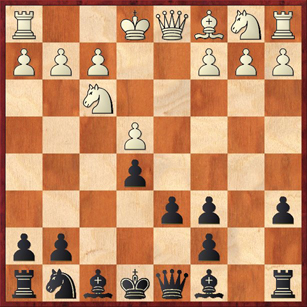
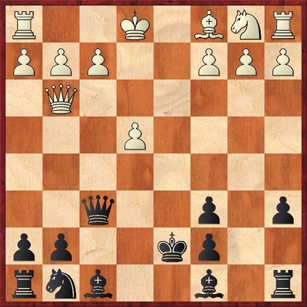
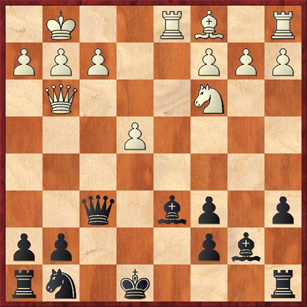

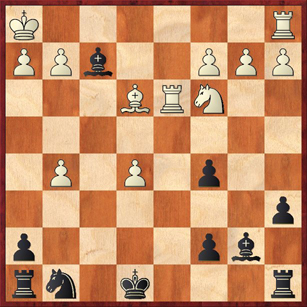
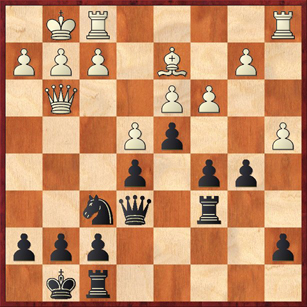
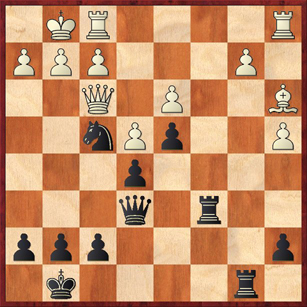
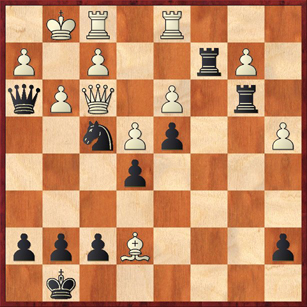



{ 3 comments… read them below or add one }
I have really enjoyed this series on your tournament win. It has been very instructive, engaging, and encouraging. It also offers more evidence for the importance of “tactics, tactics, tactics” in deciding most games. And luck in winning tournaments. And more evidence of the “second chance” or “later resource” in chess, which I have heard many GMs speak of, including Larry Evans who liked to say that even when you were losing you had to be alert because it was almost inevitable that you’d get a tactical chance to change the course of the game.
What struck me in this game is the hapless state of the white queen. It has no square but h1. Most players will not notice how vulnerable the square e2 is. If this square was defended, your combination will not work.
Also, I see two strategic errors by white. These are errors I would not know as errors just a year ago. Playing c4 to close the queenside was necessary to scope the battle on the kingside where white is somewhat stronger as the bishop points in that direction. Transferring the bishop to an inconsequential diagonal was the other error. The transfer was caused by the opening of the b-file making the choice of closing the queenside even more justified.
The other necessary move white has to make is to play h3 to give the queen luft. If the queen is on h2, then g3 is effective. One other chess bit of knowledge I recently learned is that pawn moves in front of the king such as g3 can be easily rendered weakening if the threat of capturing on f4 or h4 is prevented usually by a tactical pin.
This motif appears a lot in practical chess. Very nice game.
Thanks, MIchael and Andres! To anyone reading this, make sure to check out Michael’s blog at http://www.kenilworthchessclub.org/blog. I’ll add it to my blogroll.